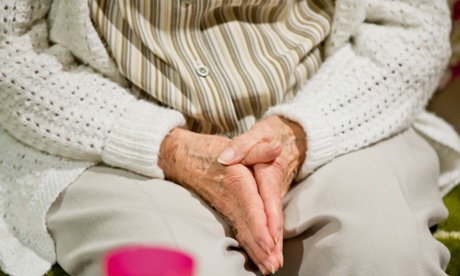One in seven Australians living below the poverty line, survey reveals
Acoss chief says findings ‘deeply disturbing’ and the 2014 federal budget is likely to push poverty rates even higher

The elderly are among those most likely to be living in poverty.
Photograph: Daniel Karmann/DPA/Corbis
Four in 10 Australians who rely on social welfare payments – and
nearly half of people on the disability support pension – are living
below the poverty line, according to a major new report.
The research, published by the Australian Council of Social Services
(Acoss), found that more than 2.5 million – or one in seven –
Australians were living in poverty in 2012, a slight increase on the
same survey two years earlier.
Nearly 18% of children live beneath the poverty line, one-third of them in sole-parent families, Acoss found.
The governor general, Peter Cosgrove, said the report revealed the
problem of poverty in Australia to be “insidious and all-encompassing”.
“It deprives [the poor] of their freedom and assaults their dignity.
As a nation we can’t allow it to continue,” he told the launch of
Anti-Poverty Week in Sydney.
The chief executive of Acoss, Dr Cassandra Goldie, said the findings
were “deeply disturbing and highlight the need for a national plan to
tackle the scourge of poverty which diminishes us all in one of the
wealthiest countries in the world”.
Single adults on less than $400 per week, and families with two
children on less than $841 each week, were deemed as living below the
poverty line.
More than half of Australians on the Newstart Allowance, 48% of
disability pensioners and 15% of aged pensioners struggle to meet basic
living costs, the report says.
“This finding brings into focus the sheer inadequacy of these
allowance payments which fall well below the poverty line,” Goldie said.
The maximum payment for a single person on Newstart is $303 per week,
nearly 25% less than what is required to stay out of poverty.
Goldie said the 2014 federal budget – particularly its proposal to
index pension payments only according to consumer price index, rather
than to the more generous average weekly earnings rate – “is likely to
result in higher poverty rates over time”.
Women, children, the elderly, Aboriginal and Torres Strait Islander
people, migrants from non-English speaking countries and people with a
disability were all most likely to be living in poverty.
“These overall findings are a wake-up call for us as a community and
shine a spotlight on the current policy direction of federal
government,” Goldie said.
New analysis released on Friday
of the government’s budget found the impact of deep cuts to government
spending “falls most heavily on low and middle-income families with
children”.
Fifteen of the 16 hardest-hit electorates were held by Labor,
including Jason Clare’s western Sydney seat of Blaxland, where
households would be $990 worse off each year.
The seats held by Tony Abbott, Malcolm Turnbull, Joe Hockey and Julie
Bishop were all largely unscathed by the harsh budget. Voters in
Turnbull’s inner-Sydney city of Wentworth would lose less than $70 in
2017, the analysis found.
Hockey told ABC television on Sunday that “variations” in the way budget measures were felt were inevitable.
“We’re reducing government expenditure, and government expenditure is
going to be less in higher-income areas than it will be in areas that
have a lower income,” he said.
But he disputed the “stereotype” that the budget hit working-class
Labor voters while sparing Liberal electorates, pointing out that the
Coalition held a number of low-income seats, and some of the country’s
wealthier electorates voted Labor.
“Frankly the stereotype is easy to create but its not necessarily right,” he said.